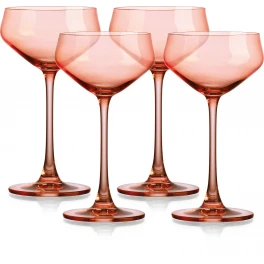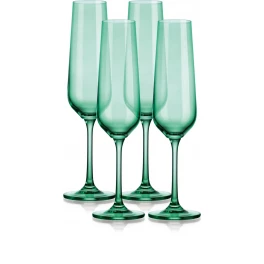We all have days of crazy schedules with quick food on the go, but sooner or later, almost everyone sits down to a group dinner. Whether eating with family or having guests over for a sitdown meal, chances are you will eventually be setting the table for dinner. If this makes you nervous, fear not. You can learn all about the best dinnerware materials and brands right here.

Photo by leisuretime70 on Shutterstock
From casual to formal place settings, there are four key components to basic table settings for dinner. Dishes, flatware, stemware, and linens. This guide will cover all four, beginning here with dishware. The end goal? Beautiful settings that fit both your style and your budget.
Whether you’re looking to upgrade or purchasing your first place settings, taking it step by step makes the process easier. Now, let’s find out what to look for when buying dinnerware.
What Is a Place Setting?
A single place setting is the dishware that one person will use during one meal. If it’s just you having a bowl of cereal, your place setting is one bowl. At most meals, it’s a little bit more than that.
When you buy dinnerware, it most often comes in four or five-piece settings. Familiarizing yourself with dinner table place setting basics can help you determine which selection is right for you. A four-piece setting is a dinner plate, a small (salad) plate, a bowl, and a coffee cup. A five-piece setting is basically the same, but with a traditional cup and saucer instead of a mug style cup. Four piece settings, like the Mikasa stoneware below, are the most common and are likely all you need unless you plan on serving traditional formal dinners.
Place settings can be purchased pre-boxed one at a time, or in groups, usually of four. A “16 piece dinner set” is basically four place settings of four pieces each. Sometimes you will see a lá carte place components offered, allowing you to build place settings that are ideal for you. I’ve noticed this most often with inexpensive tableware, but have also seen it with higher-end brands for mixing and matching, and replacement needs.
Unless you live alone and have zero interest in entertaining, it’s best to invest in a minimum of six place settings if you can. The size of your nuclear family and proclivity for hosting meals will serve as the best guide for the number of settings you need. Having eight or more not only ensures that you will be able to serve a larger number of guests, but it also holds pieces in reserve for the inevitable broken plate. Or, in my house, broken plate, bowl, and mug.
China, Porcelain, and Stoneware… What’s the Difference?
“Getting out the good china” is a familiar idea to most of us. Although china used to refer to fine ceramics that originated in the country of China, the term has morphed into a broad reference to quality dishware of any kind over the years. Technically, this isn’t really accurate.
All ceramics, including porcelain, china, and stoneware, are made of clay fired at high temperatures. The major factors in defining which is which are the strength, thickness, and porosity of the end product. These variables are all related at least in part to the firing temperature. The higher the temperature, the thinner, stronger and less porous the ceramic will be. So, what’s the best dinnerware material? Well, that depends on what you’re looking for.
Stoneware
Stoneware is more porous than china or porcelain, requiring glazing to discourage moisture absorption. It’s comparatively thick and heavy, and not always completely uniform. It’s also more prone to chipping than the harder ceramics. In general, stoneware is inexpensive to produce, and therefore fairly affordable. As far as dishware shapes, colors, and patterns go, stoneware offers a wide array of options. It’s generally dishwasher, oven, and microwave safe, and considered by many to be the best for everyday dinnerware.
China/Porcelain
Porcelain and china are fired at significantly higher temperatures than stoneware. This results in harder, thinner, stronger ceramics that are resistant to chips and scratches. For durability, china or porcelain vs. stoneware is a win for either of the former. These harder ceramics also don’t need to be glazed due to their low porosity and glassy texture but might be any way to enhance appearance.
The terms china and porcelain are often used interchangeably. The differences are probably not very important to the average consumer but may come into play if you want to purchase a prestige set of dishware. Both tend to be more costly to produce and to purchase than stoneware.
Shapes, colors, and patterns tend to be on the more conservative and/or traditional side, but that’s not a hard and fast rule. Fiesta brand china is well known for bold colors in both dishware and serving pieces, as seen here. In most cases, china and porcelain are safe to use in the dishwasher, oven, and microwave (except if they metallic pattern accents, which can’t be used in the microwave).
When it comes to durability, true porcelain is a more break resistant dinnerware than any other ceramic. Let’s face it. They make replacement hip joints out of this stuff. It’s got to last. Porcelain is fired at the highest temperatures of any ceramic and can be made thinner than non-porcelain china. Due to this thinness, it also has a beautiful translucence.
Bone China
Another fairly durable option is bone china, which is ceramic comprised of at least 25% animal bone ash. This makes the china less brittle and therefore less likely to break. Years ago, bone china was a particularly expensive type of china, but has become more affordable today. Unlike other china, it may have some translucence, though not as much as porcelain. The color tends to lean toward creamy off-white rather than pure white due to the bone ash.
Vitrified Glass
No discussion of durable dinnerware would be complete without mentioning vitrified glass dishes, the best-known brand of which is Corelle. This is an actual glass rather than ceramic dinnerware option. Vitrelle is the trademarked name for the ultra-lightweight and durable tempered glass material from which Corelle is made. Corelle dishware is chip and shatterproof, and can even be dropped without damage to the product. It’s dishwasher and microwave safe. Corelle has come a long way in appearance since its debut in 1970 but isn’t considered formal dinnerware.
To summarize: Stoneware is heavier and more likely to chip and scratch than porcelain or china, but it’s a less expensive option with tons of colors and patterns. When shopping, be aware that a high-end brand’s stoneware will likely cost more than a budget brand’s china or porcelain. If you want the option of a traditional formal look, (think place settings of at least five pieces) you should probably go with china or porcelain in a simple pattern, like the affordable Gibson china seen here.
So, is china better than stoneware? Again, it depends on your style and your needs. If you have no interest in going more formal than a dressy four-piece place setting, stoneware is a completely viable option, even for your “good china.” Just don’t expect the same long-term resistance to wear and tear that actual china and porcelain offer. Vitrified glass, such as Corelle, is an excellent choice for casual table settings.
What Brand of Dinnerware Should I Buy?
If you’re able to invest in a high-quality brand of dishes such as Lenox, Wedgwood, Mikasa, or Noritake, that’s fantastic. If not, there are plenty of affordable options that look beautiful and wear well, like Threshold (at Target,) Sonoma (at Kohl’s,) Gibson, and even Ikea. I bought a four place setting box of Gibson stoneware at a Walmart for about $25.00 ten years ago, and still use it now for everyday applications.
It’s also becoming more and more common for high-end brands to offer more affordable product lines in retail stores. I recently bought some stoneware by Chef Gordon Ramsay for Royal Doulton at about $22.00 per place setting, which is definitely at the lower end of their usual price range. By shopping at Bed Bath & Beyond, I was able to use a 20% off coupon on each box of four settings and ended up spending about $140 for eight four piece settings. Not bad. Amazing, actually.
To a certain extent, “you get what you pay for” is true of dinnerware. Major players in the game got to where they are by producing excellent products consistently. However, means of production have changed over the years, and continue to change, allowing quality to become more affordable. No matter what your price point is, there’s attractive and durable dishware available.
What Color Dishes Are Best?
Selecting a color for your dishware seems pretty straightforward. Get something you like, right? Well, yes, but stop and think a minute. A light, neutral color can be used at all major holidays and events, with diverse table décor. White is always, always a safe bet.
I had a black set of Pfaltzgraff china for a while, and while gorgeous, it didn’t work well for all occasions. (Gothic brunch, anyone?) Also, the high gloss glazed finish showed fingerprints horribly. That was an expensive purchase I didn’t really think through, and I was stuck with it for a while.
A common approach to balancing fun, colorful dishes with versatile, company dishes is buying a smaller, less expensive set for daily use, and a larger, more formal ready set for guest use. There were many years in which I had only one set of dishes, and those black Pfaltzgraff years were among them. If you’re only able to budget one set of dishes, I definitely recommend a classic white. If you’re in the position to have two sets, save the white for company days, and go with something colorful that you love for everyday use.
Now that you’ve boned up on your dishware, the next step in building your ideal setting is flatware selection. Check out Part II of House Tipster’s place setting buying guide soon, but remember, you may have to lock up your cabinets once you’re done. You don’t want the dish to run away with the spoon!
























